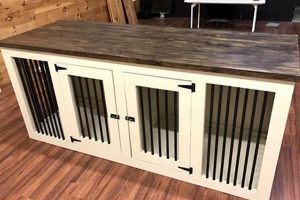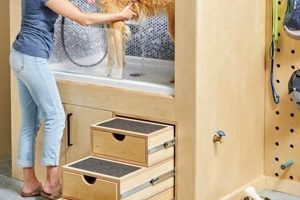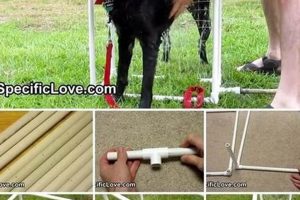The construction of canine agility training apparatus by individuals offers a cost-effective and customizable approach to enhancing a dog’s physical and mental abilities. This practice involves building obstacles such as jumps, tunnels, and weave poles using readily available materials. For example, a simple jump can be created using PVC pipes and wooden planks, while a tunnel can be fashioned from durable fabric and flexible supports.
Engaging in this construction provides several advantages. It allows for the creation of equipment tailored to a specific dog’s size and skill level. Further, it fosters a deeper bond between the owner and the dog through shared project development and training sessions. Historically, the development of homemade agility equipment has been driven by the desire to provide affordable and accessible training options for dog owners.
The subsequent sections will delve into specific designs for various obstacles, outlining the necessary materials, construction processes, and safety considerations associated with each piece of equipment. Detailed plans and instructions will enable individuals to confidently create a complete agility course within their own environment.
Considerations for Constructing Canine Agility Training Apparatus
The following guidelines are intended to enhance the safety, durability, and effectiveness of homemade canine agility equipment.
Tip 1: Material Selection: Opt for non-toxic and weather-resistant materials. Untreated wood is prone to splintering and degradation, potentially causing injury to the animal. Consider pressure-treated lumber or durable plastics for outdoor equipment. PVC pipes intended for plumbing should be schedule 40 or greater to withstand potential impact.
Tip 2: Secure Fastenings: Utilize robust fasteners such as screws and bolts, ensuring they are properly countersunk to prevent protrusions that could cause injury. Regularly inspect all connections for signs of loosening or corrosion.
Tip 3: Surface Traction: Implement non-slip surfaces on ramps, platforms, and contact zones. Rubberized coatings or textured materials can provide enhanced grip, minimizing the risk of slips and falls. Consider incorporating sand into paint for added texture.
Tip 4: Adjustable Heights: Design jumps with adjustable height settings. This enables customization to accommodate different dog breeds and skill levels. Consider using wingnuts or quick-release mechanisms for easy adjustments.
Tip 5: Tunnel Construction: Employ durable, tear-resistant fabrics for tunnel construction. Secure the fabric to a rigid frame using reinforced stitching or heavy-duty fasteners. Ensure the tunnel diameter is sufficient to accommodate the dog’s size without causing constriction.
Tip 6: Weave Pole Stability: Ensure weave poles are securely anchored to the ground. Bases should be sufficiently wide to prevent tipping. Consider using weighted bases or ground stakes for added stability.
Tip 7: Gradual Introduction: Introduce new equipment to the dog gradually. Avoid overwhelming the animal with complex obstacles. Start with simple exercises and progressively increase the difficulty as the dog gains confidence.
Tip 8: Regular Inspection: Conduct routine inspections of all equipment for signs of damage, wear, or instability. Promptly repair or replace any components that pose a potential hazard.
Adherence to these guidelines will contribute to the creation of safe and effective canine agility training apparatus, fostering a positive and enriching experience for both the dog and its handler.
The subsequent section will address common errors encountered during the construction process and provide solutions for mitigating these challenges.
1. Safety is paramount
When engaging in the construction of canine agility equipment, safety represents the foremost consideration. The inherent risks associated with physical activity are amplified when the training apparatus is inadequately designed or constructed. Substandard materials, unstable structures, and sharp edges all pose potential hazards to the animal, leading to injuries ranging from minor abrasions to more severe musculoskeletal trauma. A direct correlation exists between the level of safety incorporated into the design and construction process and the reduction of risk for the canine participant. For example, using untreated wood with the potential for splintering directly increases the risk of paw injuries, while poorly secured jump bars can lead to collisions and potential spinal injuries. Consequently, prioritization of safety is not merely a recommendation, but a fundamental requirement for ethical and responsible equipment construction.
The practical implementation of safety measures within homemade agility equipment construction encompasses several key areas. Selection of appropriate materials is critical. Non-toxic, durable, and weather-resistant materials minimize the risk of chemical exposure and structural failure. The use of rounded edges, secure fastenings, and non-slip surfaces further contributes to a safer training environment. Furthermore, design considerations must account for the specific size and physical capabilities of the canine using the equipment. Adjusting jump heights, tunnel diameters, and weave pole spacing to accommodate the dog’s dimensions reduces the likelihood of strain or injury. Regular inspection and maintenance are also essential to identify and rectify potential hazards before they manifest as accidents.
In conclusion, a comprehensive understanding of safety principles is indispensable for individuals undertaking the construction of canine agility equipment. The commitment to prioritizing safety translates directly into a safer, more effective, and more enjoyable training experience for the dog. The challenges associated with ensuring safety lie in the constant vigilance required to identify and mitigate potential hazards, as well as the willingness to invest in high-quality materials and construction techniques. Ultimately, the effort expended in prioritizing safety is a worthwhile investment in the well-being of the canine athlete.
2. Durability is important
The longevity of homemade canine agility equipment directly impacts its economic viability and the consistency of training regimes. The selection of materials and construction techniques dictates the equipment’s resistance to wear, tear, and environmental degradation.
- Material Degradation Resistance
The capacity of construction materials to withstand weathering, UV exposure, and moisture is crucial. Untreated wood, for instance, is susceptible to rot and insect infestation, significantly reducing its lifespan. Employing pressure-treated lumber, durable plastics, or applying protective coatings mitigates these risks, ensuring the equipment remains structurally sound over extended periods. This reduces the frequency of replacement or repair.
- Structural Integrity under Stress
Agility equipment experiences repetitive stress from canine impact and weight. Weak joints, inadequate support structures, or insufficiently robust materials can lead to premature failure. Reinforcing joints with metal brackets, using thicker gauge materials, and employing appropriate load-bearing designs are critical for maintaining structural integrity. A well-constructed jump bar, for example, will resist breaking under the dogs weight, preventing injury and equipment damage.
- Resistance to Canine-Induced Damage
Dogs can exert considerable force during training, potentially causing damage through chewing, scratching, or impact. Selecting materials that are resistant to these forms of abuse, such as durable fabrics for tunnels and impact-resistant plastics for weave poles, is essential. Furthermore, designing equipment with smooth surfaces and concealed fasteners minimizes potential points of damage.
- Maintenance and Repair Accessibility
Even with robust construction, some degree of maintenance and repair will be necessary over time. Designing equipment that allows for easy access to components, utilizes standardized parts, and employs simple assembly methods facilitates these tasks. For example, a jump can be designed with easily replaceable jump bars, minimizing downtime and extending the equipment’s useful life.
The investment in durable materials and construction methods translates directly into long-term cost savings and a more reliable training environment. Addressing potential weaknesses in the design and construction phase minimizes the need for frequent repairs or replacements, ultimately enhancing the overall value and usability of homemade agility equipment.
3. Cost-effectiveness matters
The financial implications associated with acquiring pre-fabricated canine agility equipment often present a significant barrier to entry for many dog owners and trainers. Commercial agility sets can be expensive, potentially limiting accessibility to this beneficial form of canine exercise and mental stimulation. The practice of constructing agility equipment independently directly addresses this economic constraint. It allows for the utilization of readily available, lower-cost materials and leverages the builder’s own labor, significantly reducing the overall expenditure. For example, scavenged lumber or recycled PVC pipe can replace commercially manufactured components, thereby minimizing the capital outlay. The availability of open-source designs and online tutorials further facilitates cost-effective construction, empowering individuals with the knowledge and resources necessary to create functional agility courses without incurring substantial expenses.
The pursuit of cost-effectiveness, however, should not compromise safety or durability. A balanced approach necessitates careful material selection, ensuring that low-cost alternatives still meet acceptable standards of structural integrity and hazard mitigation. Examples include using appropriately sized and treated lumber for jump construction or employing durable, tear-resistant fabrics for tunnel creation. While the initial cost may be lower than purchasing a ready-made product, the long-term value is contingent on the homemade equipment’s ability to withstand repeated use and environmental factors. Furthermore, the labor invested in construction represents a significant contribution, and careful planning can optimize material usage and minimize waste, enhancing the overall economic efficiency of the project.
In summary, the drive for cost-effectiveness is a primary motivator behind the popularity of constructing agility equipment independently. By utilizing readily available materials, leveraging personal skills, and prioritizing careful planning, individuals can create functional and safe agility courses at a fraction of the cost of commercially available options. The challenge lies in striking a balance between minimizing expenses and ensuring that the equipment meets acceptable standards of safety and durability. Ultimately, a well-executed, cost-effective approach to agility equipment construction expands accessibility to this beneficial activity and promotes responsible resource utilization.
4. Customization is key
The self-directed construction of canine agility equipment affords a degree of personalization unattainable through pre-manufactured products. The dimensional variances of dogs across breeds and even within breeds necessitate adjustments in obstacle height, length, and spacing. Failure to accommodate these individual needs can impede training progress, and potentially, increase the risk of injury. The ability to tailor equipment parameters to a specific dog’s physical attributes, training level, and individual learning style represents a substantial advantage of engaging in a DIY approach.
Consider, for example, the construction of a dog walk. The standard dimensions prescribed by agility organizations may not be optimal for a smaller breed or a dog with limited jumping ability. By independently constructing the dog walk, the owner can reduce the height of the planks, shorten the approach ramps, or widen the walking surface to better suit the dog’s capabilities. Similarly, tunnel diameters can be adjusted to accommodate larger breeds, preventing them from experiencing discomfort or hesitation during training. This level of granular control over equipment specifications is not typically available with commercially produced options, emphasizing the practical value of customization in the DIY context. Moreover, individuals can adapt the aesthetic qualities of the equipment to complement their training environment or reflect personal preferences.
The principle of customization extends beyond mere dimensional adjustments. The addition of textured surfaces to contact zones, the incorporation of auditory cues on specific obstacles, or the use of specialized materials designed to enhance grip can all contribute to a more effective and safer training experience. While achieving perfect standardization with a course made this way might be challenging, the flexibility inherent in self-directed construction allows for continuous refinement and optimization, promoting a more responsive and personalized approach to canine agility training.
5. Stability is a necessity
The imperative of stability in canine agility equipment, particularly within the realm of DIY construction, is paramount. Unstable equipment presents a significant risk of injury to the animal, undermining the purpose of training and potentially creating long-term aversion to the activity. The integrity of the equipment directly correlates with the safety and effectiveness of any agility course.
- Foundation Integrity
The base of any agility apparatus must provide a solid, unwavering platform. This entails utilizing materials with sufficient weight-bearing capacity and ensuring proper distribution of load. For instance, weave poles require robust bases, constructed from heavy-gauge metal or dense, appropriately treated wood, to prevent tipping during use. A stable foundation minimizes the risk of equipment collapse or displacement, which could lead to canine injury and training setbacks.
- Joint Reinforcement
The points where different components of the agility equipment connect are critical stress points. Inadequate joint reinforcement compromises the overall stability of the structure. Examples include the junctions of jump supports with the jump bar holders or the connections between tunnel segments. Using appropriate fasteners, such as bolts with locking nuts or heavy-duty screws, combined with structural adhesives, ensures that these joints remain secure under dynamic loads.
- Surface Traction
The surface of contact points, such as the dog walk or A-frame, must offer adequate traction to prevent slips and falls. Smooth or slippery surfaces contribute to instability, increasing the risk of injury. Applying textured coatings, such as rubberized paint or non-slip mats, enhances grip and promotes confident movement across the equipment. The type of coating needs to consider the material of the walking surface.
- Dynamic Load Distribution
Agility equipment is subjected to dynamic loads as the dog moves across it. Properly distributing this load across the structure is essential for maintaining stability. This requires careful consideration of the equipment’s design, including the placement of supports and the selection of materials with appropriate flexural strength. For example, ramps should be supported at multiple points to prevent sagging or bowing under the dog’s weight. Correct load distribution keeps dogs confident on the equipment.
These elements coalesce to underscore the critical role of stability in canine agility equipment. Each facet directly influences the overall safety and effectiveness of the training apparatus, highlighting the importance of meticulous design and construction practices within the DIY context. The absence of any one of these features can compromise the integrity of the equipment, increasing the risk of injury and undermining the goals of agility training.
6. Portability is desirable
The ability to readily relocate canine agility equipment is a significant advantage, particularly within the context of DIY construction. The absence of portability restricts training opportunities to a fixed location, limiting access for individuals with spatial constraints or those who desire to vary the training environment. The capacity to disassemble, transport, and reassemble agility apparatus significantly broadens the scope of potential training sites, facilitating exercise in parks, at canine events, or within different areas of a property. This adaptability directly enhances the utility and appeal of homemade agility equipment.
The attainment of portability in DIY agility equipment is achieved through several key design considerations. Modular construction, employing lightweight materials, and utilizing easily detachable components are primary strategies. For example, jump standards can be designed to collapse or fold, tunnels can be constructed from flexible, compressible fabrics, and weave poles can be mounted on removable bases. The selection of materials plays a crucial role; aluminum framing, durable plastics, and lightweight lumber offer viable alternatives to heavier materials. The inclusion of carrying handles, wheeled bases, or designated storage bags further enhances ease of transport. A DIY approach also allows for tailoring equipment size and weight to suit the individual’s physical capabilities and vehicle capacity.
The integration of portability into DIY agility equipment design presents certain challenges. Maintaining structural integrity while minimizing weight and size requires careful engineering. The use of quick-release fasteners and collapsible joints must not compromise the equipment’s stability or safety. Furthermore, durable carrying cases or storage solutions are necessary to protect the equipment during transport. Despite these challenges, the benefits of portability, including expanded training opportunities and enhanced convenience, make it a highly desirable feature in homemade canine agility equipment. The effort invested in incorporating portability considerations into the design process significantly increases the overall value and practicality of the finished product.
7. Accessibility for training
The practical significance of “accessibility for training” is directly enhanced by the option of “dog agility equipment diy”. Constructing agility apparatus independently addresses multiple facets of accessibility, including financial constraints, spatial limitations, and the customization needed for dogs with diverse physical capabilities. The cost of commercially produced equipment often restricts participation in agility training. Self-construction allows for the use of readily available, less expensive materials, thereby expanding access to a wider range of individuals. A smaller backyard or limited indoor space may not accommodate standard-sized agility equipment. DIY construction permits the creation of scaled-down, space-saving obstacles, making training feasible in confined areas. Furthermore, dogs with physical limitations, such as those recovering from injuries or senior dogs with reduced mobility, require modified equipment. Adjustable jump heights, lowered dog walks, and shortened tunnels can be readily implemented through DIY construction, allowing these dogs to participate safely and effectively.
For example, a dog owner with limited funds might construct a set of weave poles from PVC pipe and readily available lumber, enabling agility training without incurring the expense of a commercial set. An apartment dweller could build a miniature agility course consisting of small jumps and a tunnel that can be easily disassembled and stored, thereby maximizing the utilization of limited space. A trainer working with a dog recovering from surgery could create a low-impact obstacle course to facilitate rehabilitation and rebuild the dog’s confidence gradually. Each of these scenarios underscores the direct and tangible benefits of “dog agility equipment diy” in improving “accessibility for training.” The understanding of this connection empowers individuals to create customized, affordable, and accessible training environments, fostering greater participation in canine agility.
In summary, “dog agility equipment diy” serves as a crucial enabler for “accessibility for training,” overcoming financial barriers, spatial limitations, and the need for customized equipment. This approach facilitates broader participation in agility training, promoting canine well-being and strengthening the bond between dogs and their handlers. Challenges may include the need for basic construction skills and access to tools, but the long-term benefits of increased accessibility significantly outweigh these constraints, cementing the critical link between DIY construction and expanded training opportunities.
Frequently Asked Questions
The following section addresses commonly encountered inquiries regarding the construction of canine agility equipment by individuals, providing clarity and guidance on best practices.
Question 1: What constitutes the most critical factor in the construction of canine agility equipment?
Safety remains the paramount concern. Improperly constructed equipment poses a significant risk of injury to the animal, negating any potential benefits derived from training.
Question 2: Is specialized knowledge or advanced carpentry skills required for this undertaking?
While advanced skills are not strictly necessary, a foundational understanding of basic construction techniques and material properties is highly beneficial. Online resources and detailed plans can assist individuals with limited experience.
Question 3: Are specific materials essential for constructing durable and safe agility equipment?
Material selection should prioritize durability, weather resistance, and non-toxicity. Pressure-treated lumber, schedule 40 PVC pipe, and tear-resistant fabrics are frequently employed, but alternatives exist based on specific needs and budget constraints.
Question 4: How can the cost of constructing agility equipment be minimized without compromising safety?
Employing recycled or repurposed materials, optimizing material usage to reduce waste, and carefully planning the construction process are effective strategies for cost reduction. Safety should never be sacrificed for cost savings.
Question 5: What are the key considerations for adapting agility equipment to accommodate dogs of different sizes and breeds?
Adjustable jump heights, variable tunnel diameters, and customizable weave pole spacing are essential features for adapting equipment to diverse canine dimensions and physical capabilities.
Question 6: How frequently should homemade agility equipment be inspected for damage or wear?
Regular inspections, ideally before each training session, are crucial for identifying and addressing potential hazards. Prompt repair or replacement of damaged components is essential to maintain a safe training environment.
In summary, prioritizing safety, employing appropriate materials, and exercising diligence throughout the construction process are key to creating functional and reliable canine agility equipment.
The subsequent section will provide detailed plans and instructions for constructing specific agility obstacles.
Conclusion
The independent construction of canine agility equipment presents a multifaceted approach to enhancing canine training. As detailed throughout this discourse, “dog agility equipment diy” necessitates a synthesis of safety considerations, material selection expertise, structural design acumen, and an understanding of canine biomechanics. Effective implementation of these principles results in training apparatus tailored to specific needs and circumstances.
The decision to engage in “dog agility equipment diy” should be approached with a commitment to rigorous planning and diligent execution. The successful outcome, a safe and effective training environment for the canine athlete, justifies the effort invested. Continued adherence to established safety protocols and a dedication to ongoing equipment maintenance remain crucial for realizing the long-term benefits of this endeavor.







